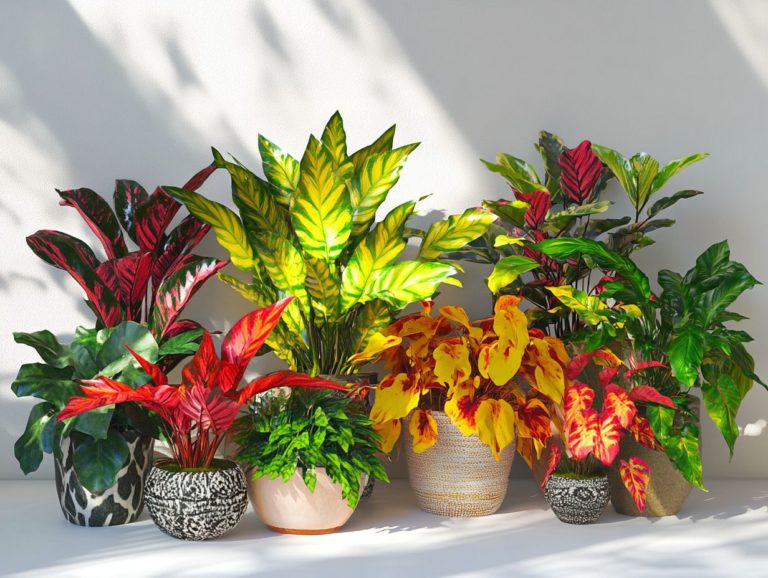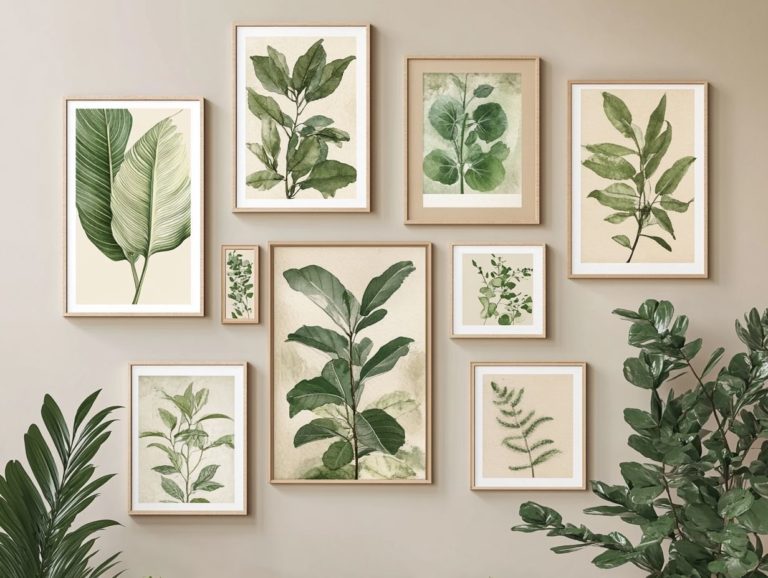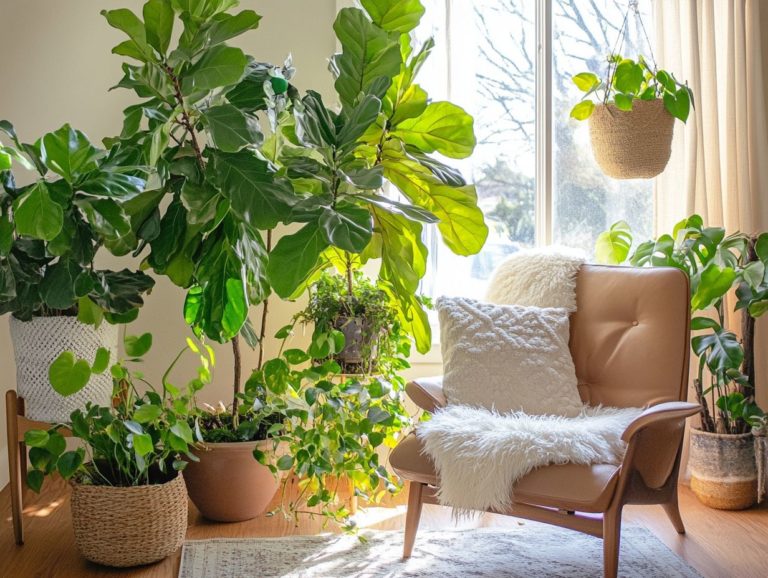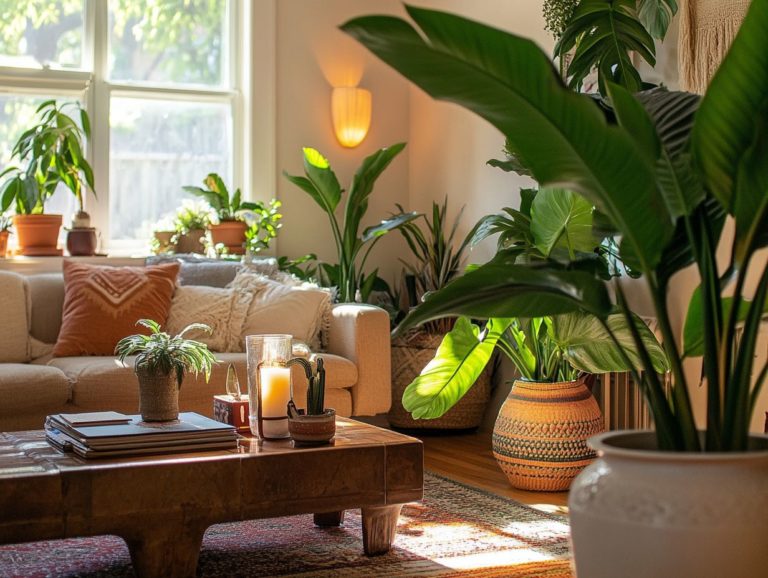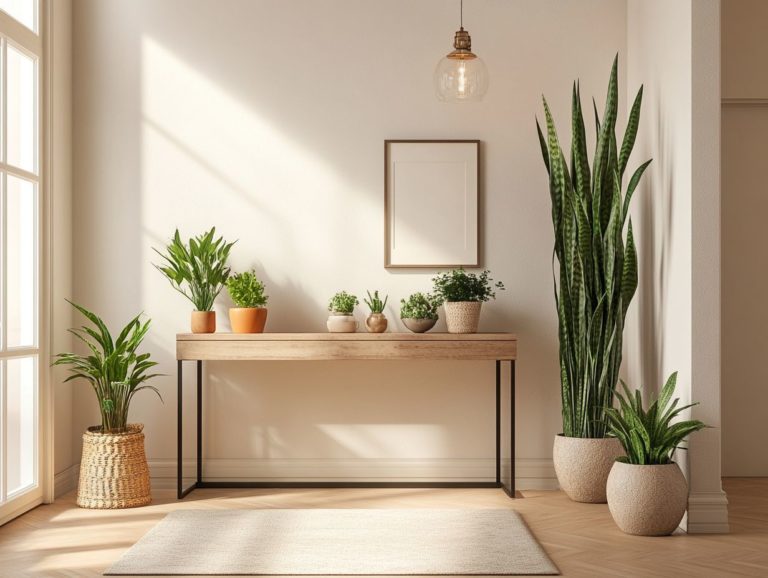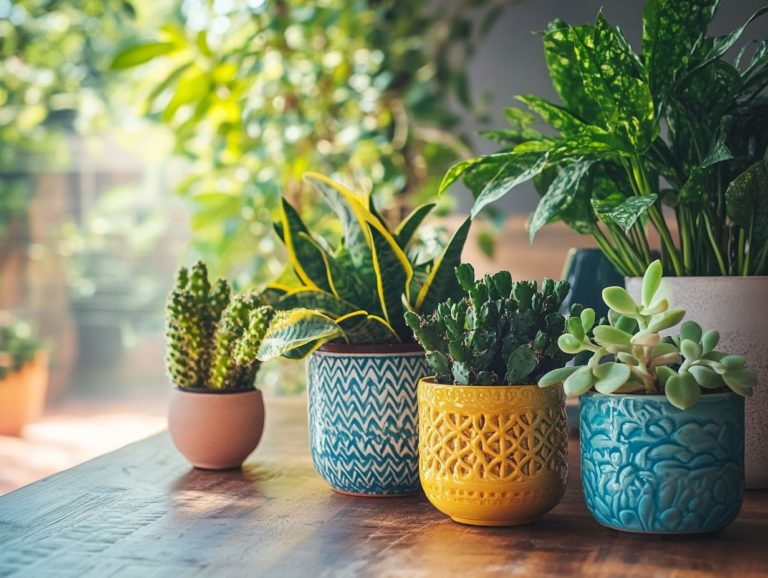Choosing the Right Indoor Plants for Your Decor
Indoor plants have emerged as essential elements in contemporary living spaces. They provide aesthetic appeal and a host of health benefits.
These verdant companions purify the air and lift your mood, effortlessly turning any room into a tranquil oasis.
Choosing the right plants requires careful thought. Consider factors like light, water needs, and placement.
This article delves into diverse types of indoor plants, offers crucial care tips, and highlights common mistakes to avoid, ensuring that your greenery flourishes and elevates your decor.
Contents
- Key Takeaways:
- Benefits of Having Indoor Plants
- Factors to Consider When Choosing Indoor Plants
- Types of Indoor Plants
- Caring for Indoor Plants
- Common Mistakes to Avoid
- Final Thoughts and Recommendations
- Frequently Asked Questions
- What are some important factors to consider when choosing indoor plants for my decor?
- Can all indoor plants thrive in any environment?
- What are some low-maintenance indoor plants that are great for beginners?
- How can I incorporate indoor plants into my small space?
- Can I mix and match different types of indoor plants in my decor?
- Are there any indoor plants that are toxic to pets or children?
Key Takeaways:
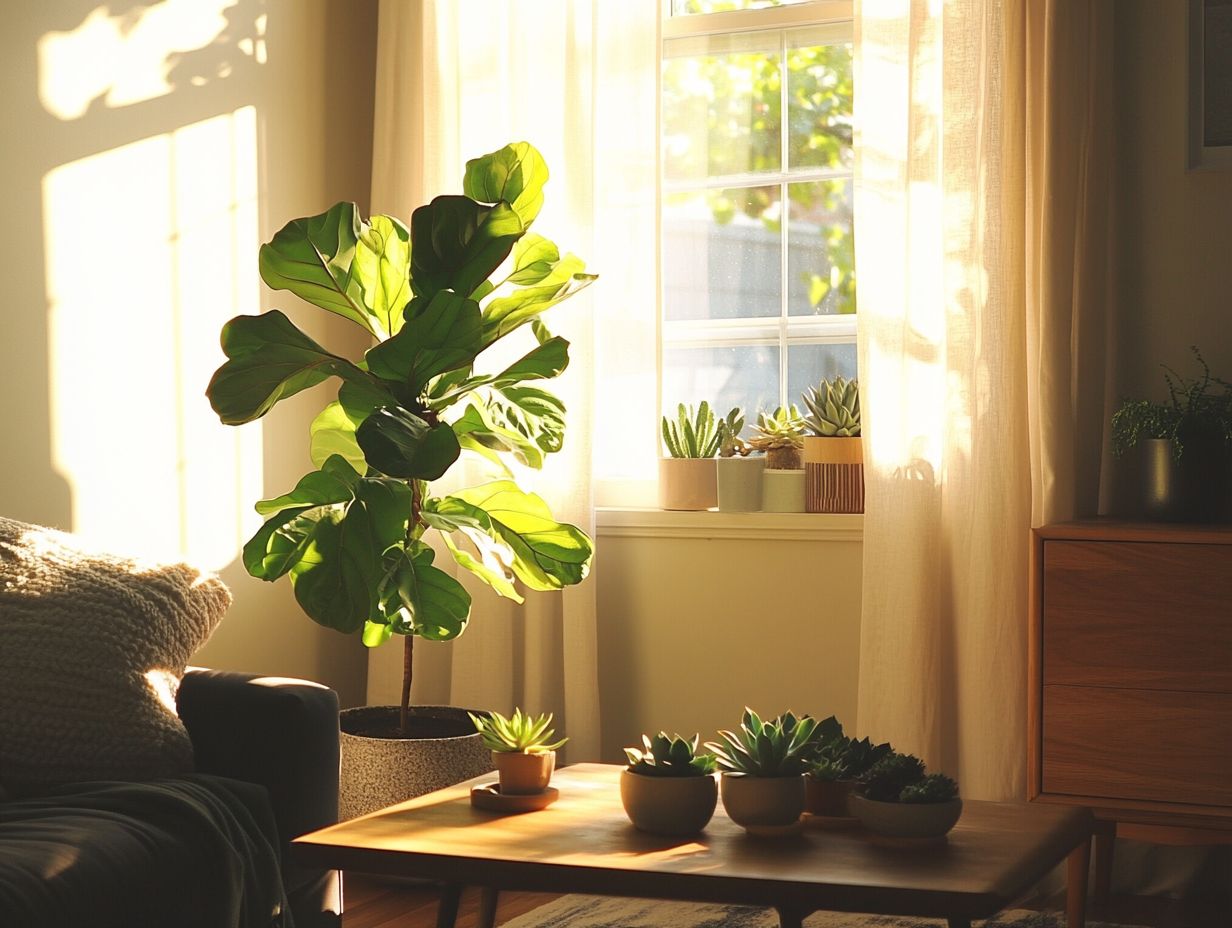
- Indoor plants add beauty and improve your health.
- Think about light and water needs when choosing plants.
- Look for low-maintenance options, perfect for any room!
Benefits of Having Indoor Plants
Indoor plants, like the Fiddle-Leaf Fig and the Monstera Deliciosa, offer a wealth of benefits for your living spaces, elevating both health and aesthetics. These stunning houseplants not only beautify your space but also purify the air, making your home healthier!
Integrating plants into your design creates a tranquil atmosphere while improving humidity levels and overall well-being. For tailored advice, a plant expert might suggest specific varieties, such as the Meyer Lemon Tree or the Kentia Palm, each known for their distinctive qualities.
Factors to Consider When Choosing Indoor Plants
Selecting the ideal indoor plants requires a thoughtful approach, taking into account vital factors like light requirements, water needs, and various growing conditions that influence plant health.
For instance, the Split-Leaf Philodendron thrives in low light, while the Meyer Lemon Tree demands bright, direct sunlight. By understanding these specific needs, you can ensure that your chosen houseplants thrive beautifully in your home office or any other space you choose to adorn.
Light and Water Requirements
Understanding the light and water requirements of your indoor plants is essential for their well-being. Take the Fiddle-Leaf Fig, for example it absolutely thrives in bright light, while the cast iron plant is perfectly happy in low light conditions.
Establishing a proper watering schedule, like aiming for weekly hydration, is vital to avoid the pitfalls of overwatering or underwatering.
Each indoor plant has its own unique needs, and recognizing this diversity is key to cultivating a vibrant indoor garden. Consider the Monstera Deliciosa: it prefers indirect light and moderate humidity, making it a favorite among many households. In contrast, the Kentia Palm flourishes in lower light levels and enjoys consistently moist soil.
The variation in light exposure not only dictates growth but also impacts how often you need to water. Adjusting your routine based on the humidity in your space and the seasonal changes will make all the difference. By tuning in to each plant’s specific needs, you can create a thriving indoor oasis.
Size and Placement
When selecting indoor plants, you must consider size and placement. They significantly impact your space. Large plants, like the African Spear Plant, can act as stunning focal points. Smaller varieties can enhance the look of your home office. Grouping plants thoughtfully creates a harmonious look, and matching containers is essential for maintaining a cohesive design theme.
To maximize visual appeal, think carefully about the dimensions of your chosen plants and the areas they will occupy. For instance, a grand floor plant can beautifully fill an empty corner, drawing the eye upward. A cluster of small succulents can soften the hard lines of a desk, especially when you consider the top indoor plants for varied lighting.
Choosing the right containers is key, as they can either elevate or clash with your interior style. In living rooms, tall plants add warmth and a sense of nature to the space, while bedrooms may benefit from smaller varieties to foster a relaxing atmosphere.
Carefully arranged plants improve aesthetics and ensure they receive enough light and ventilation, promoting their health and vitality.
Types of Indoor Plants

Explore an impressive selection of indoor plants! Each option caters to different preferences and skill levels. Whether you prefer low-maintenance options like the Sansevieria Cylindrica or are ready to take on the challenge of more demanding varieties such as the Bird of Paradise, there s something for everyone.
By understanding which plants flourish in specific rooms, you can elevate your living space and enjoy the myriad benefits they offer.
Low Maintenance Plants
If you re on the lookout for low-maintenance plants, consider:
- Cast Iron Plant
- Sansevieria Cylindrica
These hardy indoor plants require minimal care yet still bring a refreshing touch of greenery to your space. Perfect for beginners, they thrive in various environments and are incredibly forgiving.
Both of these varieties are drought-tolerant, meaning they can easily endure periods of neglect ideal for busy lifestyles or anyone who may occasionally forget to water their plants. The Cast Iron Plant, with its lush, dark green leaves, flourishes in low light. Meanwhile, Sansevieria Cylindrica features striking upright foliage that adds a contemporary flair to any d cor.
To choose the best low-maintenance options for your specific setting, consider the natural light available to you. For instance, pothos and ZZ plants also meet low-maintenance criteria, adapting well to different light conditions and requiring infrequent watering. For more detailed guidance, refer to our article on choosing the right light for house plants. They offer even more vibrant options for creating an indoor garden without the hassle.
Best Indoor Plants for Each Room
Choosing indoor plants for your specific rooms involves thought, especially regarding humidity levels and the look you want. For instance, the Meyer Lemon Tree flourishes in bright, humid spaces and can truly elevate your kitchen. A Kentia Palm brings a delightful tropical vibe to your living room.
In the bathroom, consider the peace lily; it thrives in lower light and purifies the air, fostering a calm atmosphere. In your bedroom, snake plants make for a chic addition. Their air-purifying properties can enhance your sleep quality while seamlessly blending with your design theme. To learn more about ideal arrangements, check out this guide on how to position plants in your home.
Don’t forget to match these plants with suitable pots they can really tie your décor together, boosting both functionality and visual appeal. Ultimately, selecting the right plants, like low light indoor plants tailored to each room’s unique conditions can transform your home into a vibrant indoor oasis, enhancing well-being and aesthetic harmony throughout your space.
Caring for Indoor Plants
Proper plant care is essential for maintaining the health of your indoor plants. This involves regular watering, thoughtful fertilizing, and timely pruning or repotting. Repotting means transferring a plant to a larger pot to allow for growth.
It’s important to understand the specific needs of each plant type; for instance, the Fiddle-Leaf Fig requires careful pruning to thrive. By attending to these details, you can ensure your plants not only survive but flourish over time.
Watering and Fertilizing
Effective watering and fertilizing practices are essential for maintaining the health of your indoor plants. Most plants typically thrive on a weekly watering schedule. However, fertilization needs can differ based on species. Understanding how to balance these elements can profoundly influence the growth and vitality of your plants.
To achieve optimal results, it’s crucial to keep an eye on the moisture levels. Overwatering or underwatering can lead to significant issues like root rot a condition where roots decay due to too much water or dehydration. Using a moisture meter can be a game changer, allowing you to gauge the soil’s condition and adjust your watering frequency to suit each plant’s unique needs, especially as the seasons change.
In terms of fertilizing, consider opting for organic options like compost or fish emulsion. These provide essential nutrients without the harsh chemicals often found in synthetic fertilizers. By adjusting your fertilization routine seasonally, you ensure your plants receive the right support during their growth phases, enabling them to thrive and flourish beautifully.
Pruning and Repotting

Regular pruning and repotting are crucial aspects of indoor plant care. They ensure your plants thrive and enjoy a long, healthy life. Take the Monstera Deliciosa, for instance; it benefits from occasional pruning to maintain its striking shape. On the other hand, plants like the Kentia Palm require repotting as they outgrow their containers it’s just part of the game.
Knowing when to prune or repot is just as important as mastering the techniques. Look for signs like yellowing leaves, stunted growth, or roots peeking out of drainage holes. These are clear signals that your plant is ready for a fresh start in a larger pot. This transition not only provides the much-needed space for growth but also introduces fresh, nutrient-rich soil that promotes overall vitality. For house plants like the Fiddle-Leaf Fig and the Monstera Deliciosa, understanding these signs can make a significant difference.
Techniques can vary by species; some may need a more aggressive cut, while others just require a little tidying up. By carefully observing and adjusting your care based on the unique needs of each plant, you can enhance their beauty and ensure they truly flourish in your indoor environment.
Common Mistakes to Avoid
Avoiding common mistakes in indoor plant care is essential for ensuring the health and longevity of your plants. Two of the most frequent pitfalls overwatering and underwatering can lead to stress or even death in beloved specimens like the Fiddle-Leaf Fig and Monstera Deliciosa. Selecting the right plant types for your space is crucial.
Choosing the wrong plant can stifle growth and affect your space’s aesthetic. For example, a Meyer Lemon Tree thrives in bright light, while the African Spear Plant is more suited to lower light conditions. Additionally, choosing the right water for indoor plants is vital to be mindful of these factors to cultivate a thriving indoor oasis.
Overwatering and Underwatering
Overwatering and underwatering are two common pitfalls that can significantly affect the health of your indoor plants. They can lead to the dreaded root rot or dehydration. Take the cast iron plant, for example; it’s a champion at handling underwatering, while the Fiddle-Leaf Fig demands your careful attention to prevent overwatering.
Recognizing the signs of these issues is crucial for any plant enthusiast. When you see yellowing leaves, a mushy stem, or an unpleasant odor wafting from the soil, those are your clues that you might be overwatering. On the flip side, if you notice browning leaf edges, drooping, or a dry, crumbly soil surface, it s time to consider that your plants may be thirsty.
To achieve the perfect balance, it’s important to grasp the unique water requirements of each species. Proper drainage is key. Opting for pots with drainage holes can help you avoid water accumulation. Don t overlook environmental factors like humidity levels higher humidity can assist your plants in retaining moisture, while low humidity can dry them out more quickly.
By regularly checking the moisture level of the soil and adjusting your watering habits based on your plants surroundings, you ll be well on your way to maintaining optimal hydration for your green companions. Don t let your plants suffer act now!
Choosing the Wrong Plant for Your Space
Choosing the wrong plant can lead to disappointment. Get it right to create a thriving indoor garden! Understanding environmental factors like light and humidity is essential for successful plant care.
For instance, a Meyer Lemon Tree needs bright light to thrive, while the African Spear Plant prefers lower light conditions. Matching plant types with their ideal growing conditions helps you avoid unnecessary challenges.
If you live in a humid environment, tropical plants like the Peace Lily can flourish, adding vibrancy and air-purifying benefits to your space. The Kentia Palm also thrives in such conditions.
On the other hand, if your home is drier, succulents like the jade plant offer an attractive aesthetic without needing constant moisture.
By being mindful of these factors, you can confidently curate an indoor garden that thrives and enhances the ambiance of your living space.
Final Thoughts and Recommendations
Integrating indoor plants into your home beautifies your space and cultivates a healthier living environment. If you’re considering adding some greenery, low-maintenance plants like the Castiron Plant are perfect.
It s important to select plants that match your lifestyle and care capabilities. This thoughtful selection is particularly crucial if you’re new to plant ownership; the intricacies of plant care can feel daunting.
Beginners might appreciate Philodendron care guidance to ensure success. While you may enjoy the simplicity of hardy varieties, seasoned plant aficionados can explore nurturing delicate species like the Split-Leaf Philodendron.
The allure of indoor gardening lies in the variety of options. Each plant brings unique benefits from air purification to mood enhancement. For example, the Bird of Paradise can elevate your space beautifully.
Ultimately, whether you’re just beginning or possess a green thumb, the joy of nurturing plants and witnessing their growth can infuse your living space with immense satisfaction and tranquility.
Frequently Asked Questions

What are some important factors to consider when choosing indoor plants for my decor?
When selecting indoor plants for your decor, such as the Meyer Lemon Tree or Fiddle-Leaf Fig Tree, consider their lighting, water and maintenance needs, size and shape, and compatibility with your space. Also, take into account your personal style and the overall aesthetic you want to achieve.
Can all indoor plants thrive in any environment?
No, different indoor plants have different requirements for light, water, and temperature. Varieties like Sansevieria Cylindrica can thrive in various conditions, while others may be more particular. Research the specific needs of the plants you’re interested in to ensure they suit your home environment.
What are some low-maintenance indoor plants that are great for beginners?
For those new to indoor gardening, some low-maintenance options include succulents, snake plants, peace lilies, and pothos. The Peruvian Apple Cactus is also a great choice. These plants require minimal care and can thrive in various environments.
How can I incorporate indoor plants into my small space?
If you have limited space, consider hanging plants from the ceiling or placing them on shelves or windowsills. Opt for smaller plants or those that can grow vertically, like ivy or spider plants. The Philodendron Xanadu is an excellent option for smaller settings.
Can I mix and match different types of indoor plants in my decor?
Absolutely! Mixing different types of plants, like the Ficus Lyrata with the Castiron Plant, can add visual interest and texture to your decor. Just consider the individual needs of each plant and ensure they are compatible regarding light and watering requirements.
Ready to choose the perfect plant? Let s get started!
Are there any indoor plants that are toxic to pets or children?
Yes, some indoor plants can be harmful to pets and children if swallowed. For example, the Philodendron is known to be toxic.
Before bringing any plants into your home, check if they are safe. Always keep them out of reach of curious little ones and furry friends!

